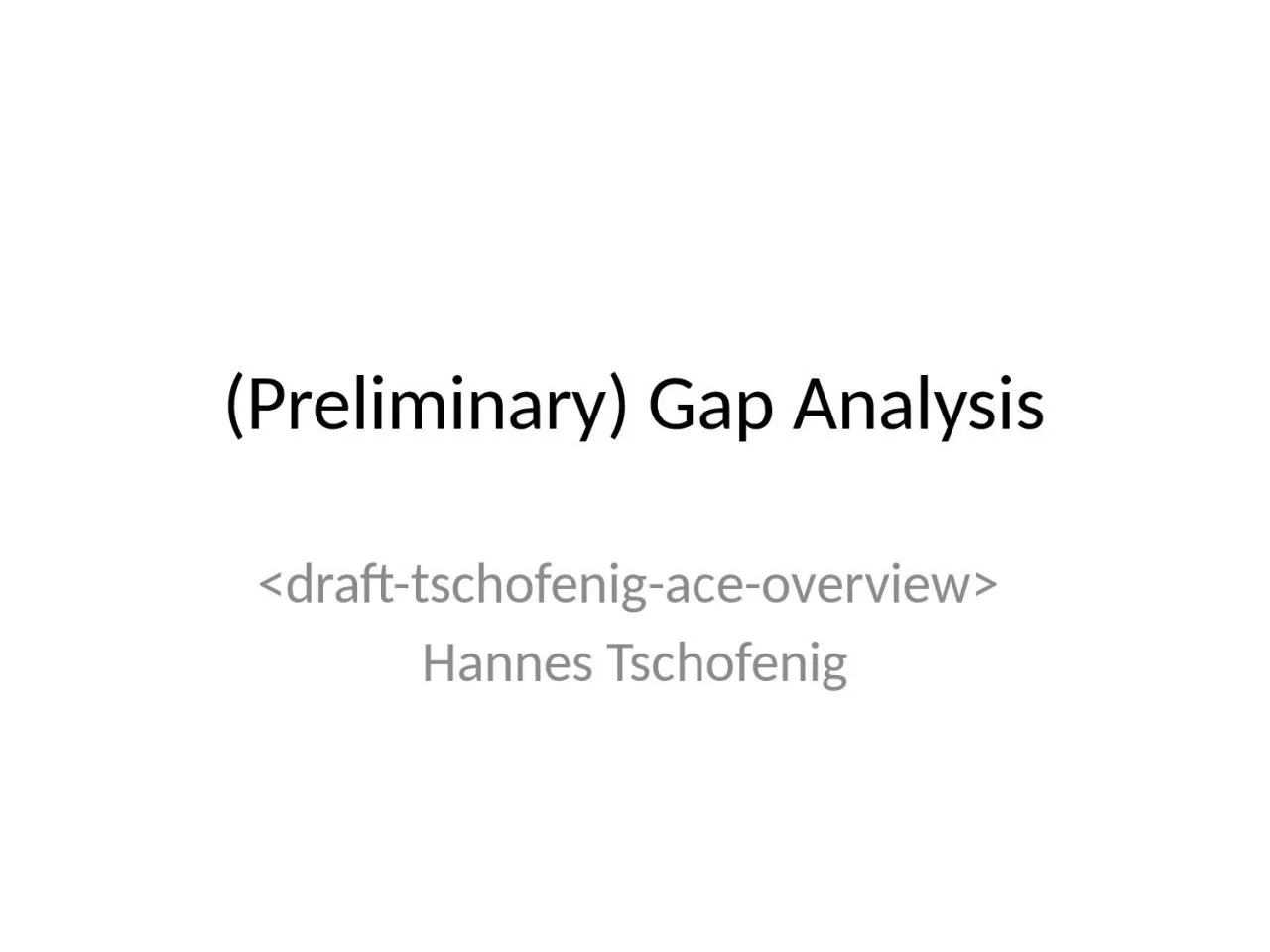

lt draft tschofenig aceoverviewgt Hannes Tschofenig Goal of this Presentation The IETF has developed a number of security technologies that are applicable to the presented use cases Is there possibility for reuse ID: 1001835
Download Presentation The PPT/PDF document "(Preliminary) Gap Analysis" is the property of its rightful owner. Permission is granted to download and print the materials on this web site for personal, non-commercial use only, and to display it on your personal computer provided you do not modify the materials and that you retain all copyright notices contained in the materials. By downloading content from our website, you accept the terms of this agreement.
1. (Preliminary) Gap Analysis<draft-tschofenig-ace-overview> Hannes Tschofenig
2. Goal of this PresentationThe IETF has developed a number of security technologies that are applicable to the presented use cases. Is there possibility for re-use?Go through a few selected technologies to identify gaps.
3. Non-GoalsDesign the solution in this room. Don’t get hung up on the details.
4. TutorialsKerberosSlidesRecordingOAuthSlides Recording “PKI/Certificate Model”SlidesRecordingAAASlides: http://www.ietf.org/edu/tutorials/IETF89-Tutorial-AAA.pdfNote: .arf files are Webex recordings. You might need to use a Webex player. See http://www.webex.com/play-webex-recording.html
5. ABFAB +---------------+ | Authorization | | Server | | | +-^----------^--+ * EAP o RADIUS * o * o +-------------+ +-v----------v--+ | | | | | Client | EAP/EAP Method | Resource | | |<****************>| Server | | | GSS-API | | | |<---------------->| | | | Application | | | | Data | | | |<================>| | +-------------+ +---------------+
6. GapsReal-time interaction between the AAA server and the resource server. ABFAB architecture uses layering of EAP within the GSS-API, which adds additional overhead. A binding for the transport of EAP payloads in CoAP, for example, does not exist.No unified authorization policy language has been defined for the AAA/EAP architecture. Instead, RADIUS attributes carry information about access control decisions.
7. Kerberos +----------------+ | Authorization | | Server | +----------------+ ^ / Request / / Ticket / / / /Ticket / /{SK}C-KDC / / / / / / / v +-----------+ +-----------+ | | Ticket + Authenticator | Resource | | Client |---------------------------->| Server | | |<===========================>| | +-----------+ Application Data +-----------+
8. GapsEach ticket is only usable for a single service (intentionally). Kerberos uses ASN.1 for encoding of the ticket and various messages. No access control policy language has been standardized. Standardization in KITTEN in progress.Proprietary policies are, however, used in real-world deployments.A CoAP binding for the KRB_PRIV and the KRB_SAFE message exchanges not been defined.Ticket and Authenticator rely on symmetric key only.
9. OAuth +-------------+ |Authorization| |Server | +-------------+ ^ / Request / / Access / / Token / /Access Token / / / / / / / / O / v /|\ +-----------+ +-----------+ | -----> | | Access Token | Resource | / \ <----- | Client |----------------->| Server | Resource | |<================>| | Owner +-----------+ Application Data +-----------+
10. GapsSupport for cross-realm interaction has not been standardized. A binding for CoAP does not exist for the client to authorization server nor for the client to resource server.The OAuth architecture does not standardize the authentication procedure of the resource owner to the authorization server itself.Profile is needed to navigate through the options (since OAuth provides a lot of flexibility). CoAP/DTLS bindings currently not defined.
11. “PKI/Certificate Model” +-------------+ |Certification| | Authority | +-------------+ ^ / Request / / Short / / Lived / /Short Lived Cert / / Certificate / / / / / / / v +-----------+ +-----------+ | | DTLS with certificate | | | | or app layer msg w/cert |Resource | | Client |---------------------------->|Server | | |<===========================>| | +-----------+ Application Data +-----------+
12. GapsThe certificate format and the PKI management protocols use ASN.1. No UDP or CoAP transport is defined for CMC/CMP/SCEP. For PKCS#10 no transport is defined at all.Asymmetric cryptography is computationally more expensive than symmetric cryptography but offers additional security benefits.
13. Conclusion… need to agree on the requirements first. There may also be other relevant security technologies as well. Our preliminary analysis makes us believe that some work is needed to get these security protocols to work on constrained devices. Need a venue to have a dialog.